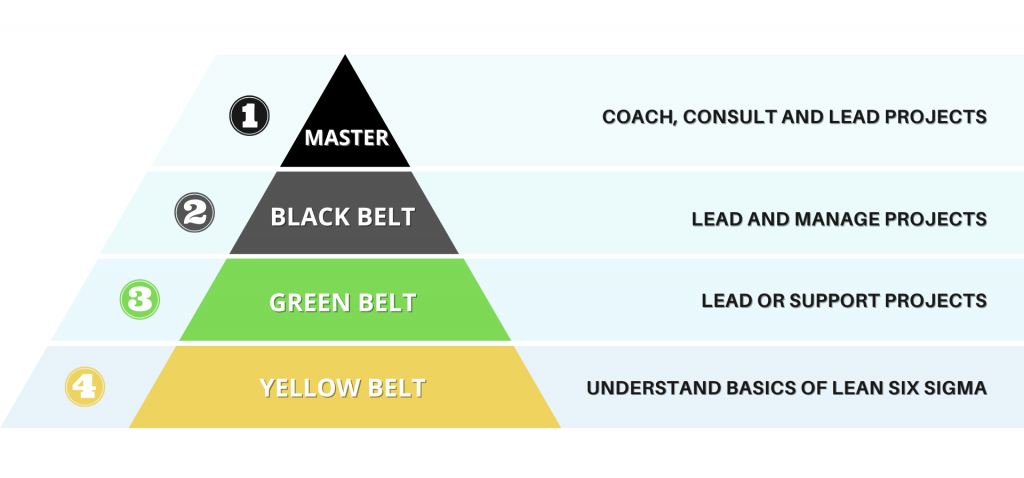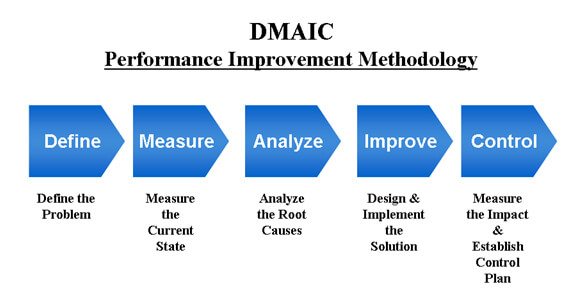Introduction to Six Sigma
Six Sigma has become one of the commonly used methodologies across industries globally. Further, there are different levels to it where you can get certified like Six Sigma Green belt, Six Sigma Yellow belt, Six Sigma Black belt, and Six Sigma Master Black belt. But have you ever wondered why Six sigma technology is becoming so popular these days? What makes this methodology so attractive for businesses? Let’s discuss this now.
Six Sigma is a methodical and data-driven technique for eradicating flaws and limitations in any business process. It works towards six values of standard deviations between the mean and closest specification limitation. So, it is very statistically oriented. Thus, it measures the quality that you see most popularly in the manufacturing of products and services. Therefore, professionals with six sigma certifications are in much demand in the industry.
In other words, Six Sigma is a well-designed set of tools and techniques that enhances customers’ experience, diminishes business costs, thereby incrementing earnings. It is a kind of specially curated quality program when learned and implemented successfully, can help in removing errors and defects in a business process. It is based on data-driven statistical analysis, to improve business processes and solve complex business problems.
What is Six Sigma Certification?
As we know, Six Sigma is a set of tools and techniques which one has to learn to apply the same in the business processes. There is a well-designed curriculum to make the learner equipped with the use of all the strategies to enhance business productivity. Six Sigma Certification is a short-term course to enhance the relevant skillset. Chiefly, a professional with the Six Sigma certification possess strong analytical and problem-solving skills. You can get yourself certified in Six Sigma Yellow Belt, Six Sigma Green Belt, Six Sigma Black Belt, or Six Sigma Master Black Belt certification. These levels are like a staircase. Consequently, the higher the level of certification, the greater is the ability to solve complex business problems. Henry Harvin is one such leading institute to provide certification at all levels.
Hence, the six sigma certification using the classification system of these ‘Belts’ is like a verification test to check your command and knowledge over the tools, techniques, and methods of six Sigma. The professionals with certification in different belts will get job positions accordingly in the corporate organizational structure.
Levels of Six Sigma Certification – ‘The Belts’
Six Sigma Certification is a type of validation test of an individual’s knowledge related to the specific competencies. It is like a quality certification which just means that the learner has completed the requirements of that specific level and is now equipped with relevant knowledge to perform tasks and duties in that specific area.
Therefore, getting certified at the Six Sigma level depicts an individual’s commitment as a quality management professional to apply his skills and strategical analysis to enhance the quality of business processes.

The levels of Six Sigma Certifications are-
1. Six Sigma Yellow Belt Certification
It is the very first level of the Six Sigma certifications family. It is a beginner’s course for those learners who do not know much about the concept of the Six Sigma world. The yellow belt certification encircles the topics covering the root understanding of the Six Sigma process as well as its fundamentals. Therefore, getting certified in the yellow belt ensures that you will gain sound conceptual knowledge of all the methods, standard tools, and techniques of six sigma to be used within an organization. Six Sigma Yellow Belt Certification Training by Henry Harvin can help you in learning all these skills.
Eligibility-
There are no perquisites required to get a yellow belt certification. The candidates need not give any exam to enroll in this as it is a beginner’s level to understand the basic concepts of Six Sigma.
Learnings under Six Sigma Yellow Belt
- Get an understanding of basic Six Sigma Concepts and techniques.
- Learning the process of data collection and methods to measure the expected outcomes.
- Gain knowledge in respect of applying Six Sigma methodology to enhance the quality of business processes and achieve the primary goals.
- Different ways to improve the daily and routine operational tasks by reducing the wasted time and cycle time to improve productivity.
Responsibilities of a Six Sigma Yellow Belt certified professional –
- To Collect data and creation of process maps.
- Work closely with the day-to-day operations of the company, thereby suggesting necessary improvements at the root level to improve the performance of the business process.
- To assist projects that are led by Green Belts and work with them to reduce the process waste by using yellow belt learning concepts and making the project a success.
- To consistently use PDCA (Plan, Do, Check and Act) method to find out the performance level of various projects.
2. Six Sigma Green Belt Certification
This is the next level in the Six Sigma belt ladder after the Six Sigma Yellow Belt and it is one of the most desired and approved levels among the certification levels of six Sigma. The Six Sigma Green Belt certification will equip the learners in such a way that they are capable of working as project members on six sigma projects. Green Belt holders are quite knowledgeable about various six sigma tools and techniques, their implementation, utilization, and measuring results. Six Sigma Green Belt Certification Training by Henry Harvin can help you in learning all these skills.
A professional in the six sigma green belt are confident to work on six sigma projects, apply DMAIC (Define, Measure, Analyze, Improve, Control) methodology to solve difficult organizational problems. The Green Belt holders generally work under the supervision of Black Belt holders.

Eligibility –
To get Six Sigma Green Belt Certified, candidates should have at least 3 years of full-time work experience in their field of expertise. However, the certification of the yellow Belt is not a prerequisite to getting this one. Also, the candidates have to give an examination and achieve the desired percentage of marks (depending upon institutes) to claim the certification.
Learning under Six Sigma Green Belt –
- Knowledge of advanced tools used in Six Sigma to improve skills.
- Learning of different statistical techniques like Normal distribution and Pareto chart.
- Gain a strong understanding of DMAIC methods
- Understanding of Kaizen, JIT, quality control practices, and many more.
Responsibilities of a Six Sigma Green Belt certified professional
- Define – Firstly, defining a problem or a challenge by project identification. It is regarding defining a case study in a business process and explaining why and how to solve the case.
- Measure – Secondly, the setting of objectives, analysis of performance standards by making sure that the newly set processes resolve to achieve the overall targets of the organization.
- Analyze – Thirdly, the hypothesis testing for variance and proportions. Tests for mean, multi-variance studies, correlation, and linear regression tests for analyzing business processes performance.
- Improve – Fourthly, it includes improving the performance and quality of the business process by eliminating waste cycles by doing root cause analysis. In this role Green belts design experiments for cycle time reduction.
- Control – Lastly, controlling the performance to ensure the goals are met. It includes the use of control charts, statistical process control methods, and control plans.
3. Six Sigma Black Belt Certification
Six Sigma Black Belt is the third level of the six sigma certifications family. Among all, it is the most advanced level of certification as the black belt holders are the professional Six Sigma project owners who lead, mentor, and guide the green belt holders under them. In other words, the Black belt encompasses all the proficiency of green belt on tools and techniques of Six Sigma. Six Sigma Black Belt Certification Training by Henry Harvin can help you in learning all these skills.
A Black Belt professional displays the quality of team leadership, stimulating change management, understanding team goals, and delegating team member roles and responsibilities for completing the six sigma projects. Black belt holders work full-time on a project.
Eligibility –
To get Six SigmaBlack Belt Certified, it is not compulsory to have Green Belt Certification. But, the candidates should have worked on the completion of one or two six Six Sigma projects or should have a minimum of 3 years of full-time experience in the fields of their expertise. Also, the candidates have to give an examination and achieve the desired percentage of marks (depending upon institutes) to claim the certification.
Learnings under Black Belt Certification –
- In-depth understanding of all the aspects of the DMAIC model (Define, Measure, Analyze, Improve, Control) in relation to six sigma principles
- Knowledge of where and how to apply Six Sigma methodology, tools, and techniques to achieve business goals.
- Trained to handle the leadership of Six Sigma projects and green belt holders.
- Learning of enterprise concepts to identify non-value-added elements.
Responsibilities of a Six Sigma Black Belt certified professional –
- Firstly, to oversee the work of Green Belt holders in the collection and analysis of data.
- Ensuring to collect accurate information and use it in the best possible way to reduce waste cycles.
- To act as a bridge between project team members and company top management for effective communication.
4. Six Sigma Master Black Belt Certification
Master Black Belt in Six Sigma is a rank assigned to an experienced Six Sigma expert. Hence, Six Sigma Master Black Belt holders are responsible to lead in the improvement of projects, implementation of strategic six sigma tools and techniques in organization structure, and training/mentoring others in Six Sigma. Six Sigma Master Black Belt Certification Training by Henry Harvin can help you in learning all these skills.
Additionally, Master Black Belt holders work towards a goal to create a culture of six sigma within the department or organization. Also, they are expected to understand the requirements of stakeholders as well as management and deploy the black belt learnings and techniques to achieve the goals of the requirements.
Learning under Six Sigma Master Black Belt Certification –
- Firstly, as this is an advanced level, you will learn how to implement six sigma techniques in unique and critical situations.
- Secondly, Six sigma has benefitted both the manufacturing as well as service-oriented processes. Thus, in Master black belt you will learn to use advanced tools to tackle complex problems in a transactional environment.
- Thirdly, this training will help you to take your DMAIC knowledge and skills to an upper level.
Responsibilities of a Six Sigma Master Black Belt professional –
- Firstly, as a master black belt professional, you will work in a full-time process improvement position.
- Secondly, a master black belt primarily trains and teaches the black belts and green belts holder under their guidance.
- They play a major role in six sigma projects in formulating key metrics and strategic planning to overcome the problem.
Why Six Sigma Certification?
Chiefly, the history of Six Sigma speaks volumes of its benefits to the organization. Do you know what are the companies which have implemented it successfully and reaped the benefits? Well, some of these companies are Ford, Motorola, GE, Amazon, U.S. Army & Marines, Boeing, McKesson, Johnson Controls, GEICO, and many more. Definitely, these names are not new to you. We all have heard these big companies’ names and yes, they have implemented six sigma technologies in their company during critical times.
As a result, this technology is now being adopted by many companies worldwide. Consequently, it is giving a boost to more people to get trained in six sigma technology.
Thus, this certification makes you an expert in solving process-specific problems, thereby increasing the career prospects of certified professionals.
In other words, Six Sigma certification focuses on testing learners for their skills with respect to identifying and eradicating defects and errors from the business processes. Therefore, a person certified in any level of six sigma should be able to tackle Six Sigma issues in projects and propose necessary changes to overcome the same.
Reasons to get Six Sigma Certification
1. For better Career prospects
Learning Six Sigma can have a tremendous impact on your future career. In other words, Six Sigma certification on your resume will fetch you better prospects as it proves your capabilities in business acumen and implementing analytical skills in critical projects. In short, a Six Sigma certification will make you stand out from the crowd.
2. Gaining Analytical Skills
During the training of Six Sigma, You will get trained in the implementation of tools like KAIZEN and Poka-Yoke, which are proven techniques of achieving fast results thereby improving your analytical skills. Six Sigma professionals can solve the issues of reducing waste cycle, complaint resolution time, cost overruns, invoicing errors, etc. with their strong calculative and analytical mind.
3. Preparing for leadership
Once you get certified in the Six Sigma black belt, you are prepared to lead the strategic project team. You not only get yourself equipped in tools, techniques, and methodologies of six sigma but also become the change agent within the organization. You will be showcasing your leadership skills by coaching yellow and green belts under your guidance. Therefore, quality products are delivered to customers by your leading efforts to improve the business processes.
4. Achieve and implement DMAIC skills
Six Sigma certification helps you to achieve the in-depth knowledge to understand the features of an organization’s manufacturing and business processes, thereby implementing DMAIC (Define, Measure, Analyze, Improve, and control) skills to manage them. Therefore, all these skills are imperative for you to get hired by any business organization.
5. Lead the competitive market
This certification will make you competitive to find opportunities in various industries across the world. The methodologies of six sigma are now being applied in almost all industries globally. Therefore, having a six sigma certification will be like an entry card for you to switch within industries as well as in diverse sectors. Hence, the scope will be broader for you from the IT industry to Healthcare, security, financial sector, Automation, investment banking, and many more.
Benefits of Six Sigma to the Organization
Just like we discussed the benefits to an individual of getting six sigma certified, similarly an organization is also benefitted by hiring a six sigma professional. The expertise and knowledge of a six sigma-certified person bring positive changes in many different areas of a business. For e.g., improving the quality of goods and services, reducing waste cycles, eliminating errors in business processes, etc.
So, let’s discuss the benefits of using Six Sigma to improve a business operation.
1. Increased Customer Satisfaction
The application of Six Sigma methodologies in a business leads to error-free processes and better quality control. Consequently, it will result in increasing the quality of the end-product Thus, good quality products always fetch business happy and satisfied customers.
2. Retaining Customers
Satisfied customers are always loyal to the product and keep on making future purchases for the same brand if the product fulfills its quality standards. So, to retain their customers, business organizations need six sigma professionals to manage and control the business and manufacturing processes to maintain quality products.
3. Increased Revenue
When customers are happy, they will definitely spread the word about the products to others. As a result, businesses will get more customers and more sales. Consequently, it leads to an increased revenue stream.
4. Increased Efficiency
Evidently, with the implementation of strategically designed six sigma tools and techniques in the business process, errors and defects can be eliminated. As a result, the efficiency of production is also increased. Consequently, this will ensure to meet the upcoming rise in demands of goods and services.
5. Better partnerships
When a business does well with the application of six sigma methodologies, other companies associated can also benefit from it. This can help to gain long-term partnership benefits as well as encourage other companies to employ six sigma strategies for their companies.
Career Path After Getting Six Sigma Certification
The six sigma certification hold volumes of opportunities. Doing the Six Sigma course is not an easy job as it requires persistent training, focus, and hours of learning to practice the tools and techniques of six sigma methodologies. But, hard work always pays well. That is why there are ample career opportunities with well-paying jobs are available in the market once you get certified.
Following are a few of the major six sigma professional roles you can get yourselves hired in –
- Process Development Engineer
- Data Scientist
- Operating System Specialist
- Lean Six Sigma Consultant
- Business Process Analyst
- Senior IT Project Manager
- Reliability Engineer
- Lead Manufacturing Engineer
- Warehouse Operations Manager
- Compliance Structural Engineer
And Last Words
As you can see, getting a Six Sigma certification is advantageous for you as well as for the business organizations. Six Sigma methodologies can boost a company’s revenue by retaining customers, making them happy as well as satisfied. Chiefly, it results in increased employee satisfaction, as well as enhancing your skills, marketability, and chances of getting quality employment. Undoubtedly, it will be a wise idea to invest in getting yourself a certification in Six Sigma.
Six Sigma Certification in Texas
Six Sigma Certification in Florida
Frequently Asked Questions (FAQs)
Two engineers named Bill Smith and Mikel Harry, who worked in Motorola, developed the mechanism of Six Sigma in 1986. Later in 1995, Jack Welch adopted Six Sigma as a central strategy of a business in GE.
To get a certification in Six Sigma Green Belt, the learner should have a minimum of 3 years of experience in the respective field of expertise.
The five stages of six Sigma are termed DMAIC – Define, Measure, Analyze, Improve, and Control.
Yes, you can get training of Six Sigma online by Live classes and give online exams too. The pattern allows you to take exams at your convenience.
The Green Belt holders are trained in such a way that they can work as project team members thereby starting their journey on a path towards leadership. On the other hand, Black Belt holders have already completed that journey. Black belt holders are the professional Six Sigma project owners who lead, mentor, and guide the green belt holders under them.











WHAT IS SIX SIGMA CERTIFICATION blog was best..!! Interesting blog..!!